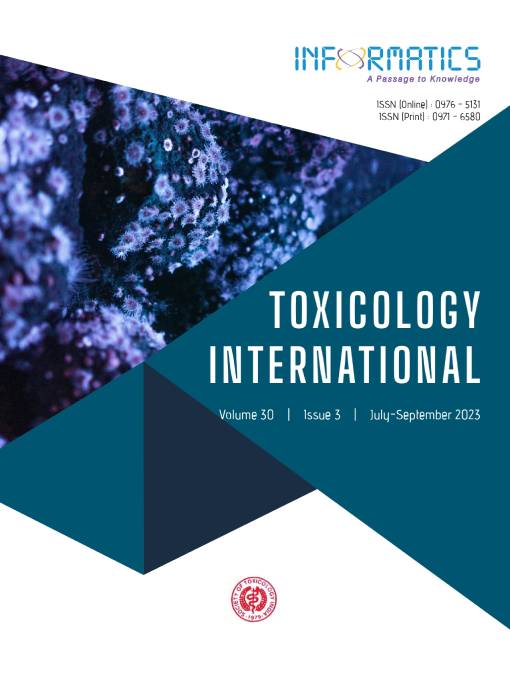Toxicological Evaluation of Vaisvanara churna an Ayurvedic Formulation
DOI:
https://doi.org/10.18311/ti/2023/v30i3/33491Keywords:
Acute Toxicity, Chronic Toxicity, Median Lethal Dose, NOAEL, Therapeutic Dose, Vaisvanara churnaAbstract
Vaisvanara churna an ayurvedic formulation was screened for its toxicity profile. The study was carried out based on CCRAS Protocols. For the acute oral toxicity study, Group I served as vehicle control, Vaisvanara churna at a single oral dose of 6500 mg/kg b.w., was administered to 5 male and 5 female Swiss albino mice (Group II) and observed for 14 consecutive days for clinical signs, body weight and mortality. For 90 days repeated dose toxicity study eighty animals (40 male and 40 female) were distributed into four groups. Group I served as vehicle control. Groups II, III, and IV were administered with 450, 2250 and 4500 mg/kg b.w., respectively for 90 days orally. During this period, feed intake, body weight, signs of toxicity, haematological and biochemical parameters were recorded at periodical intervals. After 90 days animals were sacrificed for necropsy, vital organs were weighed and preserved for histopathological analysis. In an acute toxicity study, a single dose of Vaisvanara churna at 6500 mg/kg b.w., caused no mortality in animals, suggesting that the median lethal dose is greater than 6500 mg/kg b.w. In 90-day, repeated dose toxicity study, administration of Vaisvanara churna for 90 days, up to 4500 mg/kg b.w., caused no significant changes in body weights or organ weights of rats in the treated groups when compared with the control group. In addition, haematological and biochemical parameters were within the physiological limits. Histopathological analysis revealed no signs of degeneration. These results showed that Vaisvanara churna is apparently safe as indicated therapeutically for long-term administration for chronic ailments.
Downloads
Published
How to Cite
Issue
Section
Accepted 2023-05-12
Published 2023-09-20
References
Paudyal B, Thapa A, Sigdel KR, Adhikari S, Basnyat B. Adverse events with ayurvedic medicines-possible adulteration and some inherent toxicities. Wellcome Open Res. 2019; 4:23. https://doi.org/10.12688/wellcomeopenres.15096.3 PMID: 31641694; PMCID: PMC6790910. DOI: https://doi.org/10.12688/wellcomeopenres.15096.3
Pandey MM, Rastogi S, Rawat AK. Indian traditional ayurvedic system of medicine and nutritional supplementation. Evid Based Complement Alternat Med. 2013; 2013. https://doi.org/10.1155/2013/376327 PMID: 23864888; PMCID: PMC3705899. DOI: https://doi.org/10.1155/2013/376327
Ekor M. The growing use of herbal medicines: Issues relating to adverse reactions and challenges in monitoring safety. Front Pharmacol. 2014; 4:177. https://doi. org/10.3389/fphar.2013.00177 PMID: 24454289; PMCID: PMC3887317. DOI: https://doi.org/10.3389/fphar.2013.00177
Bhardwaj A, Jha K, Panka A, Agarwal A, Singh B, Trivedi N. Evaluation of standardization parameter of polyherbal digestive churna. Indian J Pharm Biol Res. 2017; 5(2):39-45. https://doi.org/10.30750/ijpbr.5.2.8 DOI: https://doi.org/10.30750/ijpbr.5.2.8
Sarker MR. Therapeutic efficacy and safety of traditional ayurvedic medicines: Demands for extensive research and publications. No. 03, OMICS Publishing Group; 2014. https://doi.org/10.4172/2167-1206.1000e113 DOI: https://doi.org/10.4172/2167-1206.1000e113
The Ayurvedic pharmacopeia of India: Part II (Formulations). (i) Ministry of health and family welfare. New Delhi; 2007. p. 59-60.
Central Council for Research in Ayurvedic Sciences. General guideline for safety/toxicity evaluation of ayurvedic formulations. New Delhi: Ministry of AYUSH, Government of India; 2018. Available from: http://www. ccras.nic.in/sites/default/files/viewpdf/Publication/ CCRAS_Guideline%20of%20Safety_Toxicity.pdf
OECD. Guideline for testing of chemicals 423-Acute Oral toxicity; 2006. Available from: https://www.oecd-ilibrary. org/environment/test-no-423-acute-oral-toxicity-acutetoxic- class-method_9789264071001-en
OECD. Guideline for the testing of Chemicals 408-90 days repeated dose oral toxicity study; 1995. Available from: https://www.oecd-ilibrary.org/environment/test-no- 408-repeated-dose-90-day-oral-toxicity-study-in-rodents_ 9789264070707-en
Teo S, Stirling D, Thomas S, Hoberman A, Kiorpes A, Khetani V. A 90-day oral gavage toxicity study of D-methylphenidate and D,L-methylphenidate in Sprague– Dawley Rats. Toxicology. 2002; 179(3):183-96. https://doi. org/10.1016/S0300-483X(02)00338-4 DOI: https://doi.org/10.1016/S0300-483X(02)00338-4
Ali R, Jaimini A, Nishad DK, Mittal G, Chaurasia OP, Kumar R, et al. Acute and sub acute toxicity and efficacy studies of Hippophae rhamnoides based herbal antioxidant supplement. Indian J Pharmacol. 2012; 44(4):504-8. https:// doi.org/10.4103/0253-7613.99329 DOI: https://doi.org/10.4103/0253-7613.99329
Hayes AW, Kruger CL. Hayes Principles and Methods of Toxicology. 6th ed. CRC Press; 2015. https://doi.org/10.1201/ b17359
Raza M, Al-Shabanah OA, El-Hadiyah TM, Al-Majed AA. Effect of prolonged vigabatrin treatment on hematological and biochemical parameters in plasma, liver and kidney of Swiss albino mice. Scientia Pharmaceutica. 2002; 70(2):135- 45. https://doi.org/10.3797/scipharm.aut-02-16 DOI: https://doi.org/10.3797/scipharm.aut-02-16
 R. Ilavarasan
R. Ilavarasan







